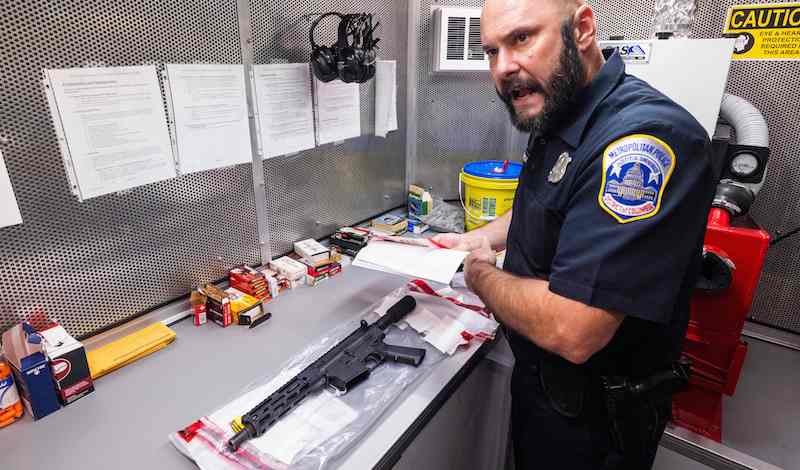
The Justice Department issued a new final rule regulating guns that can be assembled at home.
The word “ghost” can bring up different images—a supernatural specter, a luxury car, or a person who, without warning, stops returning your calls. The U.S. Department of Justice, however, wants to eradicate “ghosts” in an area less often associated with them: firearms.
On April 11, President Joseph R. Biden announced a new final rule issued by the Bureau of Alcohol, Tobacco, Firearms, and Explosives (ATF)—an agency within the Justice Department—regulating guns that can be assembled at home. These guns are known as “ghost guns,” reflecting the fact that, because they lack serial numbers, these guns cannot be traced back to their owners.
The new rule makes changes to earlier regulations adopted under the Gun Control Act of 1968. One especially notable change is that the new rule expands the definition of “firearm,” making gun kits equivalent to preassembled regulated firearms. One important consequence is that anyone seeking to buy a gun kit must undergo a background check. Any privately assembled firearms—that is, firearms assembled from a kit—that do not come with identifying markings must be identified or marked by whoever is assembling the guns so that law enforcement officials can trace them.
President Biden justified the new rule by pointing to the increasing availability of ghost guns—and an increase in crime committed using ghost guns. In 2020, local law enforcement agencies reported 8,712 suspected ghost guns to the ATF, which represents a more than 400 percent increase from 2016.
Proponents of the rule argue that it is necessary to close loopholes in gun regulation. They also support the rule as a necessary public safety measure.
Former ATF agent David Chipman argues that the rule does not impose much of a burden because the only people who buy ghost guns are people who want to avoid background checks, such as “criminals or extremists.”
Critics, however, have raised legal questions about the rule. They argue, first, that the Justice Department has exceeded its statutory authority. This argument rests on critics’ reading of a provision in the Firearms Owners’ Protection Act of 1986 that amends the Gun Control Act to allow the Attorney General to prescribe “only such rules and regulations as are necessary.” Because these critics think that regulations of unassembled kits are not necessary to public safety, they contend that the Justice Department has exceeded its limited rulemaking authority.
Individuals who submitted comments to the ATF in opposition to its rule also argued that the rule’s definition of “firearm” to include unassembled kits runs contrary to the Gun Control Act’s definition of “firearm.” These commenters argued that, because the Gun Control Act defines a “firearm” as a “weapon that can be readily converted to expel” projectiles, expanding the initial definition of a firearm to include weapons kits contradicts the plain reading of the statute.
Supporters of the rule, though, counter that the Justice Department has authority to adopt the rule under the Gun Control Act because the rule is “consistent with Congress’s intent to regulate the core component of the firearm.” The Justice Department also argues that the Gun Control Act’s definition of “firearm” covers weapons that can easily be converted to fire, not just weapons that are preassembled and ready to fire.
If the rule is defended as falling within a broad reading of the word “firearm,” critics say that this raises a different problem: the rule then violates the nondelegation doctrine. Under that doctrine, statutes cannot give open-ended authority to agencies because only the U.S. Congress has the constitutionally granted power to write laws. A majority of the justices currently on the U.S. Supreme Court have expressed sympathy for increasing scrutiny of laws on this basis.
At a minimum, any grant of authority must be based on statute-based guidelines directing officials how to exercise delegated power. But the Gun Control Act, critics argue, does not contain an “intelligible principle” to guide ATF’s rulemaking.
The Justice Department responded to nondelegation critiques by noting that the Supreme Court has found that statutes authorizing agencies to regulate in the public interest contain “intelligible principles.”
Lawmakers have expressed concern about the rule as well. On April 14, U.S. Senators Ted Cruz (R-Texas), James Lankford (R-Okla.), and Mike Lee (R-Utah) announced that they would introduce a joint resolution of disapproval of the rule pursuant to the Congressional Review Act (CRA). Senator Lankford called the rule “another attempt by the Biden Administration to strip law-abiding citizens of their Second Amendment rights,” and Senator Lee argued that the rule violates the Firearms Owners’ Protection Act’s prohibition of a federal gun registry.
Even if the senators have enough votes to succeed in gaining a majority for a resolution of disapproval, their effort to overturn the rule through a CRA resolution does not look likely to succeed. After all, it would require approval from both the U.S. Senate and the U.S. House of Representatives, as well as the President’s signature.
One might even say that reversal of the ATF rule through the CRA’s procedure does not seem to stand a ghost of a chance. Challenges through the courts, however, might reach a different result.



